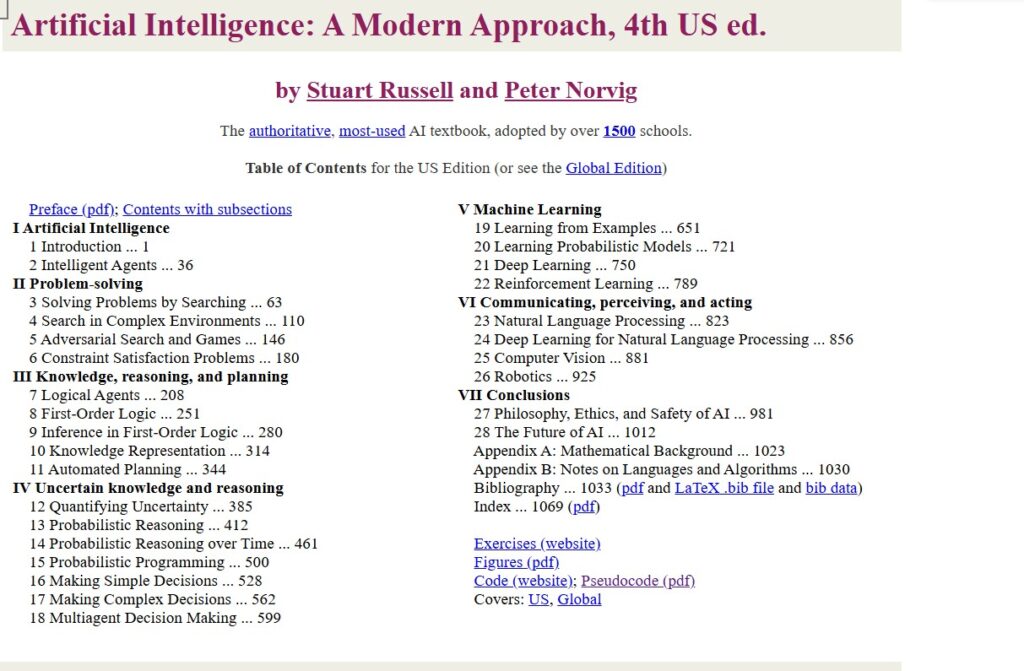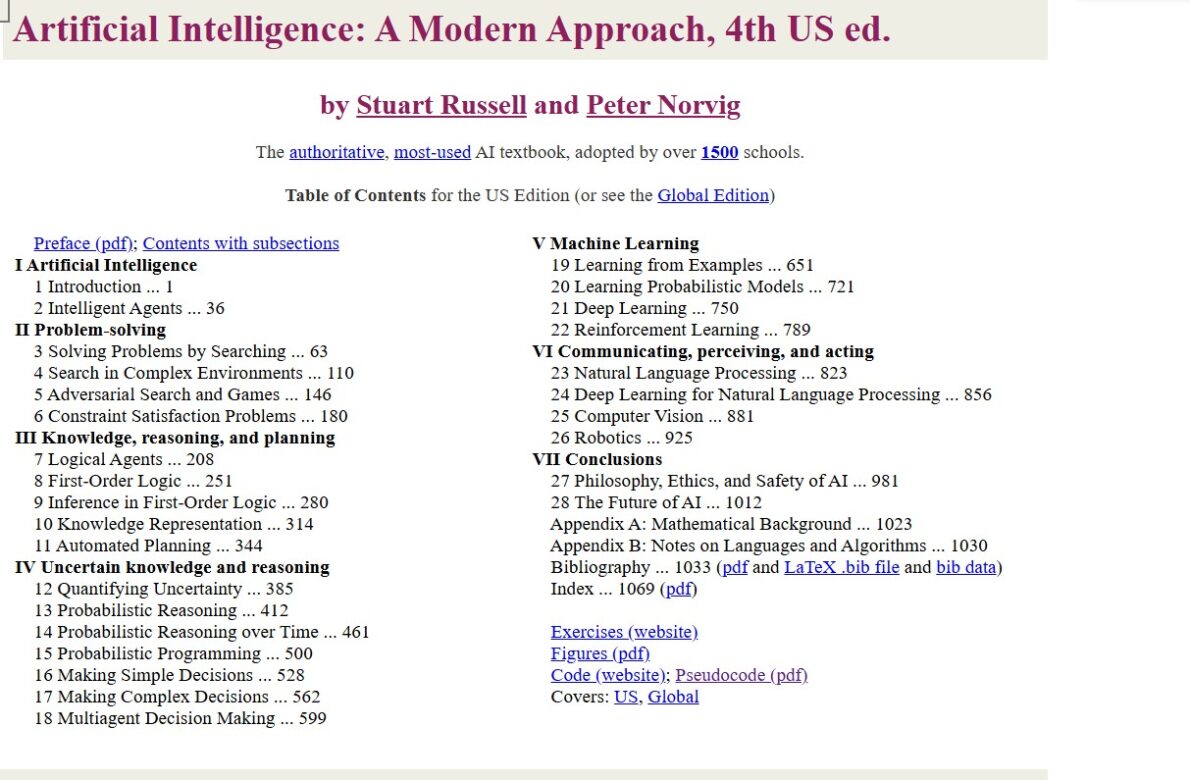When it comes to learning artificial intelligence (AI), few resources hold as much authority as “Artificial Intelligence: A Modern Approach” by Stuart Russell and Peter Norvig. Often regarded as the “Bible of AI”, this textbook has become the most widely used academic reference in the field adopted by over 1,500 universities and institutions worldwide.

Published initially in the 1990s and now in its 4th edition, the book has evolved alongside AI itself covering everything from classical logic-based systems to deep learning, probabilistic reasoning and the ethical implications of AI in society.
In this article, we’ll explore why this book remains the gold standard for AI education, its key sections and what makes it an indispensable resource for both beginners and advanced learners.
Why “Artificial Intelligence: A Modern Approach” Is Considered the AI Bible
There are countless books and online courses available today that teach AI, but none have had the same long-term academic and practical influence as Russell and Norvig’s textbook.
Here’s why:
- Comprehensive coverage: The book bridges theoretical foundations and real-world applications across all core domains of AI — including search algorithms, reasoning, probabilistic models, machine learning, computer vision, natural language processing and robotics.
- Depth and rigor: It doesn’t just explain concepts superficially; it provides mathematical depth, pseudocode examples and exercises for deep understanding.
- Universally adopted: Used in top universities like Stanford, MIT, UC Berkeley, and Carnegie Mellon, it serves as the standard curriculum text for introductory and advanced AI courses.
- Continuously updated: Each edition incorporates the latest developments in AI from reinforcement learning and deep learning to topics like AI safety and ethics.
Overview of the Book’s Structure
The book Artificial Intelligence: A Modern Approach is divided into seven major parts, each representing a key dimension of AI. Let’s break them down.
I. Artificial Intelligence (Introduction)
The opening chapters provide an overview of AI, introducing the concept of intelligent agents – entities that perceive their environment and take actions to maximize their success. This section lays the groundwork by explaining what AI is, its history and its major subfields.
II. Problem Solving
This part delves into search algorithms, which are fundamental to how AI systems find solutions.
Topics include:
- Uninformed and informed search strategies
- A* algorithm and heuristic-based methods
- Adversarial search and game theory
- Constraint satisfaction problems
This section teaches how computers make decisions and find optimal paths which are critical for areas like robotics and route optimization.
III. Knowledge, Reasoning, and Planning
AI systems need to represent and reason about knowledge. This section explains logical agents, first-order logic and automated planning. Readers learn how AI uses symbolic reasoning to draw conclusions and plan actions. These foundations are key for expert systems, theorem provers and decision-making models.
IV. Uncertain Knowledge and Reasoning
Real-world data is rarely perfect – uncertainty is everywhere. Here, Russell and Norvig introduce probability theory, Bayesian networks and Markov models to help AI make sound decisions under uncertainty. This section is especially important for machine learning and probabilistic programming.
V. Machine Learning
This is one of the most popular and modern parts of the book.
It covers:
- Supervised and unsupervised learning
- Probabilistic models and neural networks
- Deep learning fundamentals
- Reinforcement learning and policy optimization
It provides both theoretical foundations and practical algorithms that power today’s large language models and computer vision systems.
VI. Communicating, Perceiving, and Acting
This section explores how AI interacts with the world focusing on Natural Language Processing (NLP), computer vision and robotics. Topics like transformers, image recognition and autonomous navigation are explained in depth.
VII. Conclusions: Philosophy, Ethics, and the Future of AI
The final chapters discuss the ethical and philosophical dimensions of AI. As systems become more autonomous, the authors explore crucial questions:
- How should AI align with human values?
- What are the risks of uncontrolled AI systems?
- How can we design safe and fair algorithms?
These chapters highlight the importance of AI safety, transparency, and alignment issues that dominate modern discussions around responsible AI development.
Additional Learning Resources Included
The authors go beyond just the textbook content. The official AI: A Modern Approach website provides free access to:
- Exercises and solutions for self-practice
- Visual figures and pseudocode examples
- Online code implementations
- Mathematical appendices for deeper exploration
Together, these resources turn the book into a complete self-learning package for anyone aiming to master AI from the ground up.
Who Should Read This Book?
The beauty of “Artificial Intelligence: A Modern Approach” lies in its versatility.
It’s suitable for:
- Students beginning their journey in AI or computer science
- Researchers and engineers looking to strengthen their theoretical foundation
- Educators designing AI curricula
- AI professionals wanting to revisit core principles amid today’s rapid technological changes
Whether you’re learning about search algorithms for the first time or studying deep learning architectures, the book “Artificial Intelligence: A Modern Approach” provides a timeless framework to understand how intelligent systems work.
Conclusion
Even as AI technologies evolve rapidly with tools like GPT-5, Claude, and Gemini dominating headlines — the principles explained in “Artificial Intelligence: A Modern Approach” remain essential. It continues to be the most authoritative and widely used guide for understanding both classical and modern AI systems.
For anyone serious about mastering artificial intelligence whether academically, professionally or out of pure curiosity — this book is not just a reference but a roadmap to the entire field.
Follow us for cutting-edge updates in AI & explore the world of LLMs, deep learning, NLP and AI agents with us.
Related Reads
- 15+ Gemini AI Photo Editing Prompts for Boys: Create Stunning Styles & Expressions in 2025
- ROMA: The Ultimate AI Framework That Lets You Build High-Performance Agents in Minutes
- How oLLM Makes Large-Context AI Models Run Smoothly on 8GB GPUs
- Gamma PPT AI : Unlock Presentations in Minutes
- PyMuPDF: The Ultimate Python Library for High-Performance PDF Processing
References
Artificial Intelligence: A Modern Approach – Official Website
Artificial Intelligence: A Modern Approach – Wikipedia
Center for Human-Compatible Artificial Intelligence (CHAI) – UC Berkeley
Stuart J. Russell – UC Berkeley Faculty Profile
Peter Norvig – Author and AI Researcher (Amazon Profile)


3 thoughts on “Artificial Intelligence: A Modern Approach — The Ultimate Number 1 Guide to Learning AI by Stuart Russell and Peter Norvig”